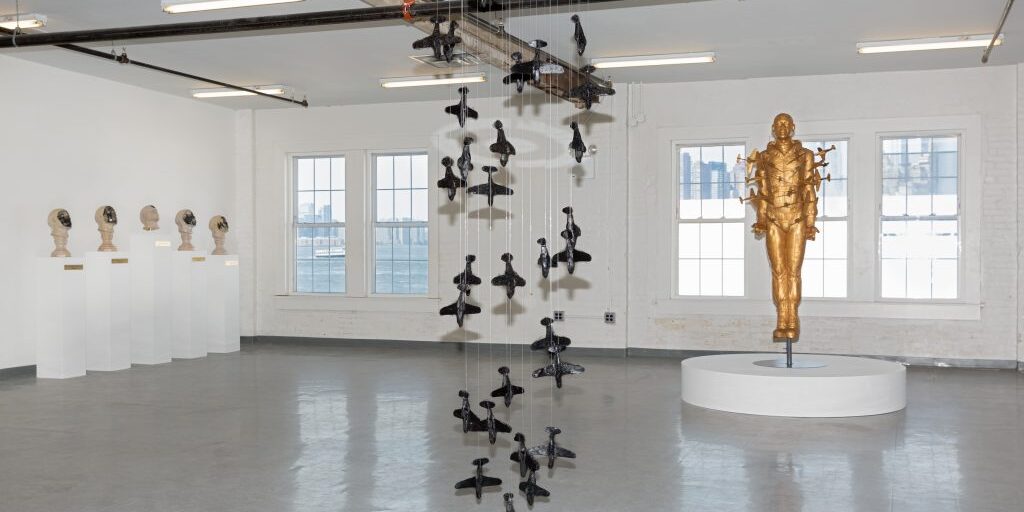LMCC was founded in 1973 as Lower Manhattan Cultural Council with the belief that artists and communities are interconnected, each contributing to a more just, equitable, and sustainable society.
For almost five decades, we have advanced our vision to serve, connect, and make space for artists and communities in NYC through programs that deepen artists' creative practice and afford them opportunities to share their process and work with local communities.
In practice, this includes our Artist Residencies programs that provide studio space, professional development, and networking opportunities to enable artists to develop their work (Workspace, Extended Life, and The Arts Center Residencies), and our Grants programs to artists and organizations that support hundreds of local and neighborhood arts projects (Manhattan Arts Grants and SU-CASA).
Our support of grassroots local arts programming created by recipients of our Manhattan Arts Grants, and our own self-produced Public Programs (River To River Festival, Open Studios), bring performances and artistic experiences to hundreds of thousands of audience members annually.
In 2019, we opened our newly renovated and expanded The Arts Center at Governors Island, a 40,000 square foot arts space that fully connects to our vision of making space and serving artists and communities, while offering much-needed programs for all, all for free.
Read on to learn more about the rich legacy of LMCC.
1973 - 2001: Birth of LMCC
Founded in 1973 by Flory Barnett with support from David Rockefeller, Sr. and Chase Manhattan Bank, New York State Council on the Arts (NYSCA), and other local business and civic leaders, Lower Manhattan Cultural Council (LMCC) was built on the premise that artists were pillars of resilience and inspiration and therefore vital to New York City.
Our organization’s core mission included forging meaningful connections with individual artists, arts groups, public officials, community groups, property owners and developers, and other employers as well as stakeholders in the downtown and cultural landscapes at large.
Using public plazas, parks and atria, LMCC brought communities together by sponsoring free lunchtime concerts and evening performances on the plaza, installations in lobby windows, and outdoor sculpture exhibitions. LMCC grew with the Financial District, cultivating art and culture in and around the World Trade Center. Soon after our inception, we published a monthly calendar of area cultural programming, Downtown, that included local lectures, walking tours, concerts, and other myriad events.
By the end of the 1990s, we had not only moved our offices into the World Trade Center (WTC), we had transformed it into a cultural anchor: our programs now included World Views, which offered studio space to artists in the upper floors of the North Tower; Evening Stars, which brought free dance to the WTC Plaza; and exhibition spaces throughout the complex showcased the work of artists of all disciplines.
LMCC also expanded its reach boroughwide with Manhattan Arts Grants, where we regranted funding to local arts organizations and individual artists for diverse programs and presentations: Manhattan Community Arts Fund began in 1984; The Fund for Creative Communities began in 1998; and Creative Curricula began in 2003.
In these years, demand for LMCC’s programs among artists and audiences flourished, and in response, the organization grew in programmatic scope, community impact, and capacity.
2001 - 2011: 9/11 and Lower Manhattan’s Recovery
On September 11, 2001, when the World Trade Center was destroyed, LMCC lost a home, a performance venue, studio and exhibition spaces, and nearly 30 years of archives. Most significantly, we lost an artist-in-residence, Michael Richards, who perished alongside thousands of others.
In the years following, we focused on arts-driven resiliency and cultural revitalization in the Financial District. Funds provided support for emerging visual artists from the Caribbean and of Caribbean descent, and the Gulf Coast Residency offered a temporary residency in Lower Manhattan for 15 artists displaced by Hurricane Katrina. In 2004, LMCC was awarded a five million dollar grant from the September 11th Fund in order to restore and sustain the activities of Lower Manhattan's cultural community. Over the next three years, we distributed those funds to small and mid-sized cultural organizations and activities in Chinatown and below Canal Street through our Downtown Culture Grants Initiative.
We also launched Workspace, a nine-month residency program that provides emerging artists with free studio space and professional development, and began the Paris Residency. This partnership between LMCC and the Mayor’s Office of the City of Paris provides a New York City artist with the opportunity to live and create at Cité Internationale des Arts in Paris for six months.
During these years, LMCC continued re-grant the highest amount of city and state arts funds to artists and organizations in Manhattan through our Manhattan Arts Grants. In 2002, we also became a founder of the River To River Festival, the largest free arts festival celebrating artistic diversity and site-specific performances in Lower Manhattan that continues today.
Perhaps the most significant and visible growth was our creation of The Arts Center at Governors Island, which established yearly artist residencies and summer public programming in Building 110 on Governors Island.

2012 - 2018: Re-growth and Expansion
The past decade saw a new wave of growth for LMCC that continued throughout Manhattan, including the revitalization of Governors Island in arts and culture, and partnerships that facilitated programs and research along Lower Manhattan’s waterfronts, as well as the expansion of funding arts into Upper Manhattan.
In February 2011, LMCC took over as the lead organizer and curator of the River To River Festival after many years of producing festival events. Two years later, we launched Paths to Pier 42 as part of the Arts East River Waterfront Initiative, a series of partnerships between LMCC and local community organizations that brought murals, public arts installations, performances, and other events to formerly vacant spaces along the East River Waterfront.
In 2016, we curated and presented Michael Richards: Winged, an exhibit of the artist’s prescient work on flight and blackness, at LMCC's Arts Center.
Borough-wide initiatives continued to expand through our Manhattan administration of SU-CASA, a city-funded, community arts engagement program that places artists and organizations in twenty senior centers throughout New York City.
In 2018, with funding from Upper Manhattan Empowerment Zone (UMEZ), LMCC developed the Upper Manhattan Arts Engagement (UMAE) grant, a new extension of our existing Manhattan Arts Grants programs to provides Upper Manhattan-based artists and arts organizations with financial resources for public presentations.
2019 - Present
In 2019, LMCC awarded over $1.4 million dollars in grant funding to over 200 Manhattan-based artists and arts organizations. Additionally, we completed an exciting renovation and expansion of LMCC's Art Center that ultimately doubled its size and better serve both artists and visiting members of the public.
On September 19, 2019, we re-opened The Arts Center at Governors Island, our first permanent home for artists and audiences, and the gateway to Governors Island’s Historic District. Conceived as an incubator for creative experimentation and a public gathering space, The Arts Center is a 40,000 square foot building that includes artist studios, galleries, performance space, and a café, fully embodying LMCC’s mission “to serve, connect, and make space for artists and community” in Manhattan and beyond. We welcomed the public to the newly expanded Arts Center with a series of exhibitions and programs that focused on ecology and sustainability.
In 2020, we experienced a sustained period of collective trauma, rife with the murder of innocent Black lives; incessant ideological, psychological and physical attacks against the AAPI community; staggering loss and sickness from the COVID-19 pandemic; and an overwhelming sense of isolation. Although we shut down our physical offices in mid-March, we continued working remotely to help alleviate the unprecedented level of disruption to artists’ practices, and loss of income and employment by providing them space and support during the COVID-19 pandemic. We created a benefit auction where proceed went to the artists, including LMCC alumni artists, and presented a socially distanced River To River Festival that explored the power of community and solidarity through four unique artist voices.
In 2020, we also spearheaded a new initiative with the Trust for Governors Island (TGI) and numerous Island-based organizations in response to the COVID-19 crisis and its devastating impacts across the NYC cultural landscape. Under the Governors Island Residency Initiative, participating organizations repositioned indoor spaces on the Island historically used for exhibitions and public programming as residencies or work spaces for artists and other members of the City’s cultural community in 2020. We transitioned a significant portion of The Arts Center at Governors Island's facilities to accommodate between artists as a part of this open call.
When city COVID-19 restrictions lifted, we were thrilled to reopen The Arts Center at Governors Island to the public in June 2021, and present a carefully curated River To River Festival that took NYC history as its starting point. We welcomed visitors and artists to our Arts Center exhibitions, open Studios with artists-in-residence, and The Take Care Series, a set of monthly public programs that offer opportunities for audiences to experience art and one’s own creative potential on and beyond Governors Island. In addition, we supported artists through our grants and SU-CASA programs, and in our yearlong Arts Center Residencies.
LMCC turned 50 in 2023. We remain committed to serving artists, audiences, and communities throughout Manhattan and visitors to our beloved borough; reexamining the structural inequities and white supremacy that underlie our own place of privilege, and continuing the work of reform. We continue to animate sites and spaces through the work of our artists in Manhattan’s office buildings, storefronts, public plazas and parks, waterfront esplanades and piers, national monuments, and so much more. Our projects address and respond to changing forces in urban life and the art world, and we continue to contribute to a thriving and culturally-enriched New York City.
Through listening, dialogue, advocacy, and activism, we participate in the necessary work to eradicate institutionalized racism. Our aim is to collectively build a more just, equitable, and inclusive society that supports and strengthens all people through the power of art and creativity - not just those who are privileged because of the color of their skin.
